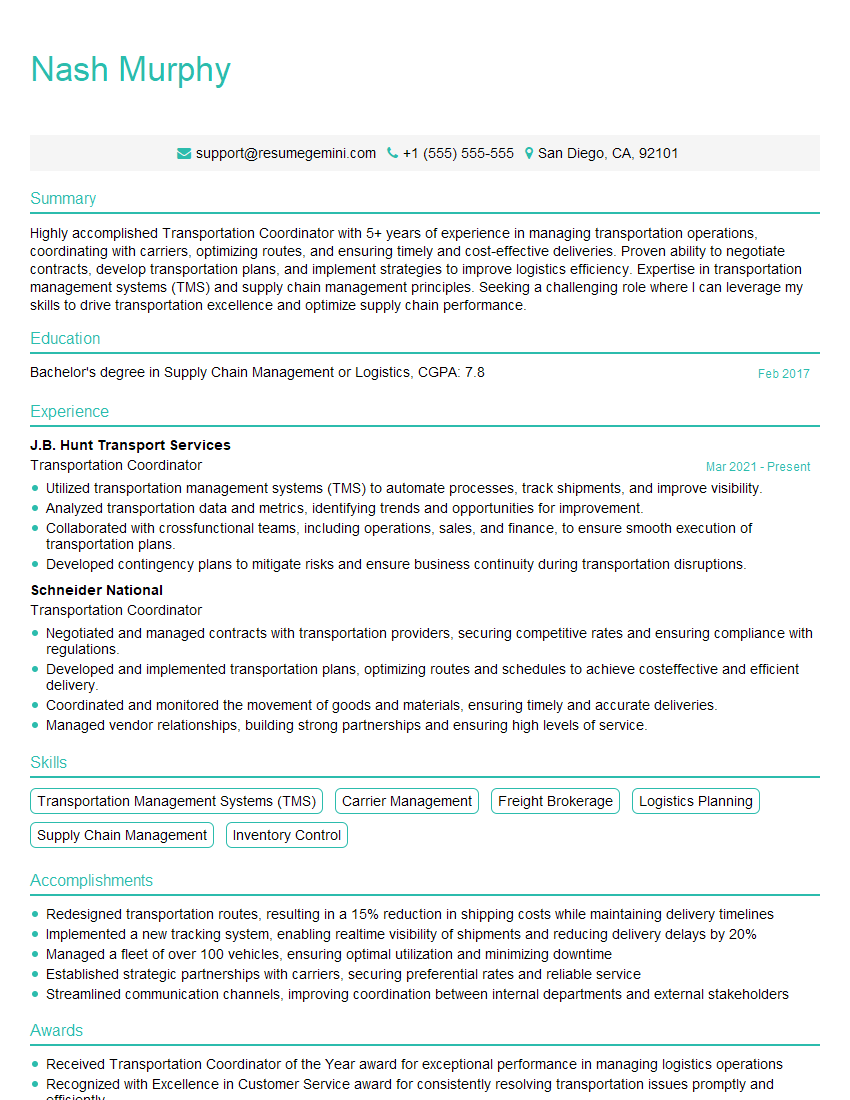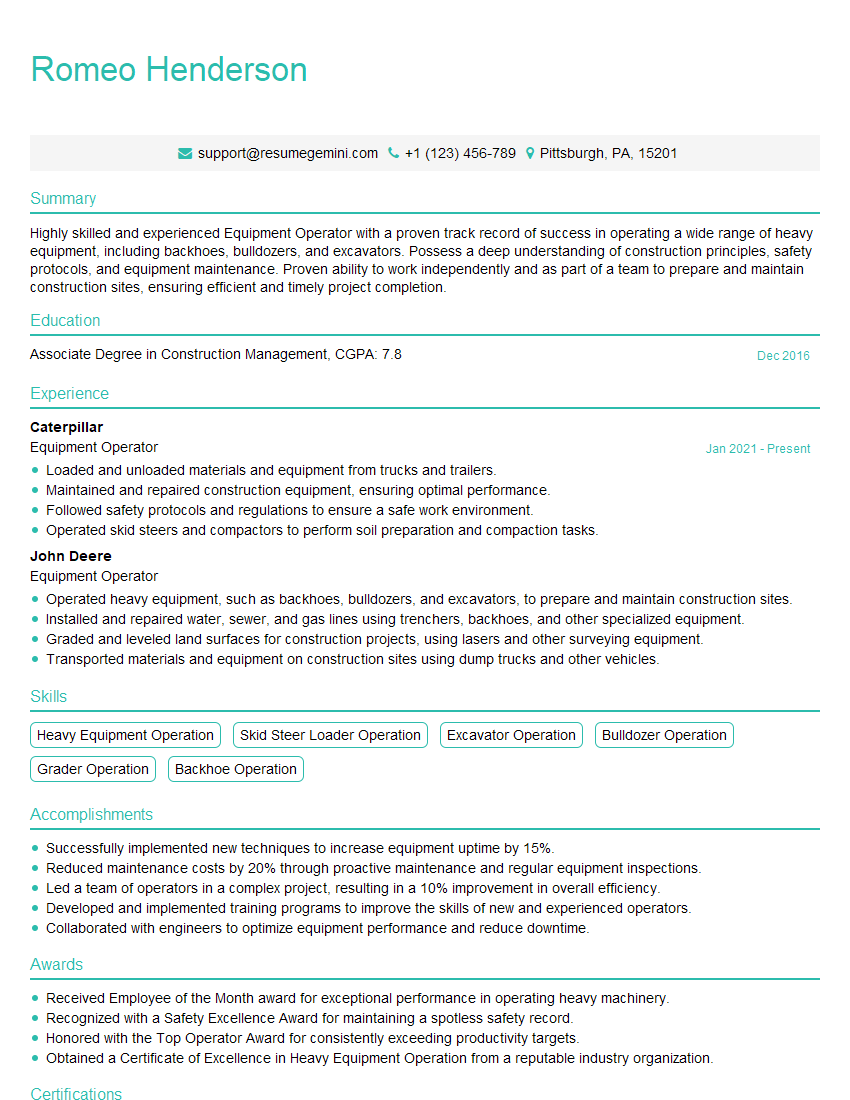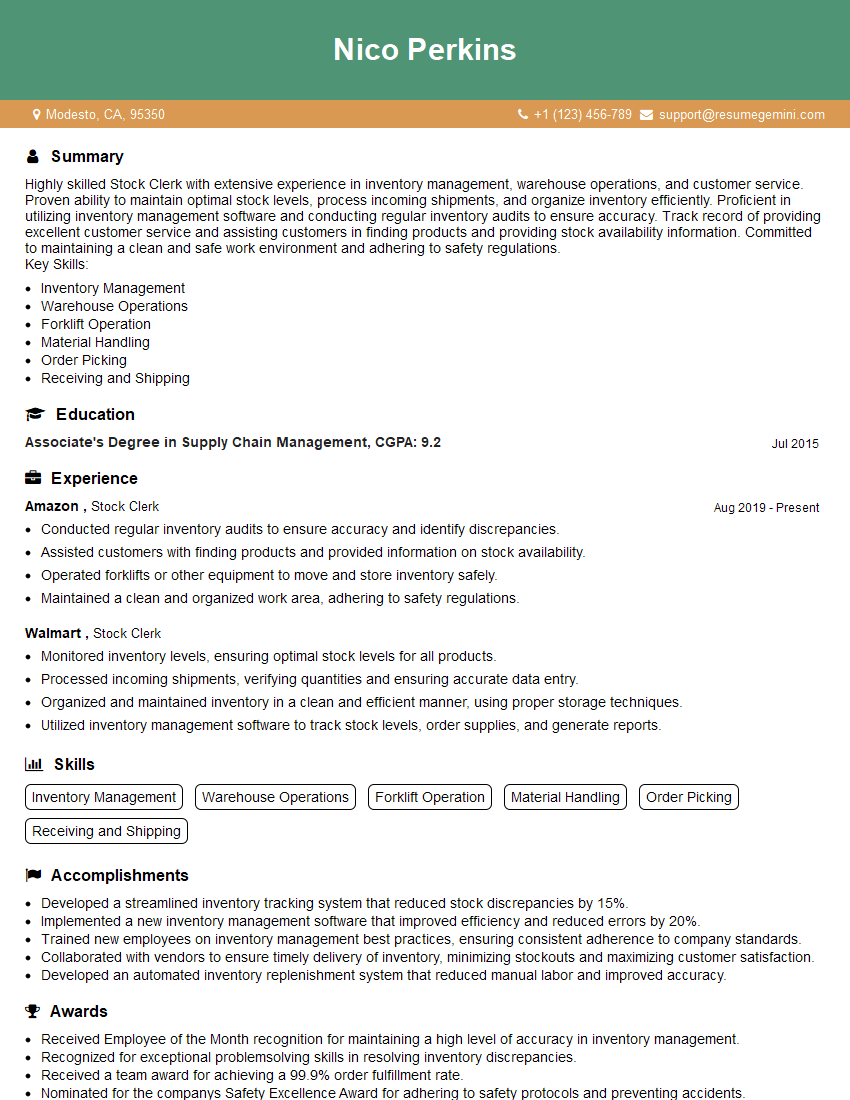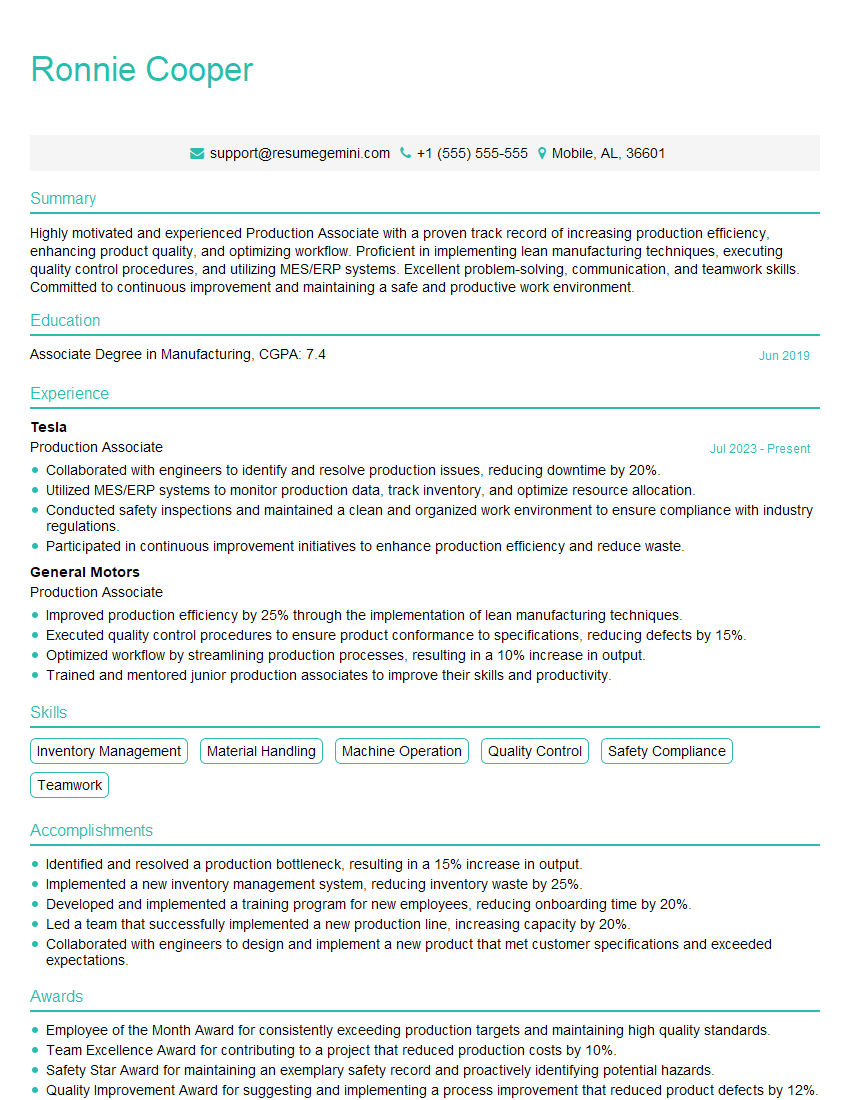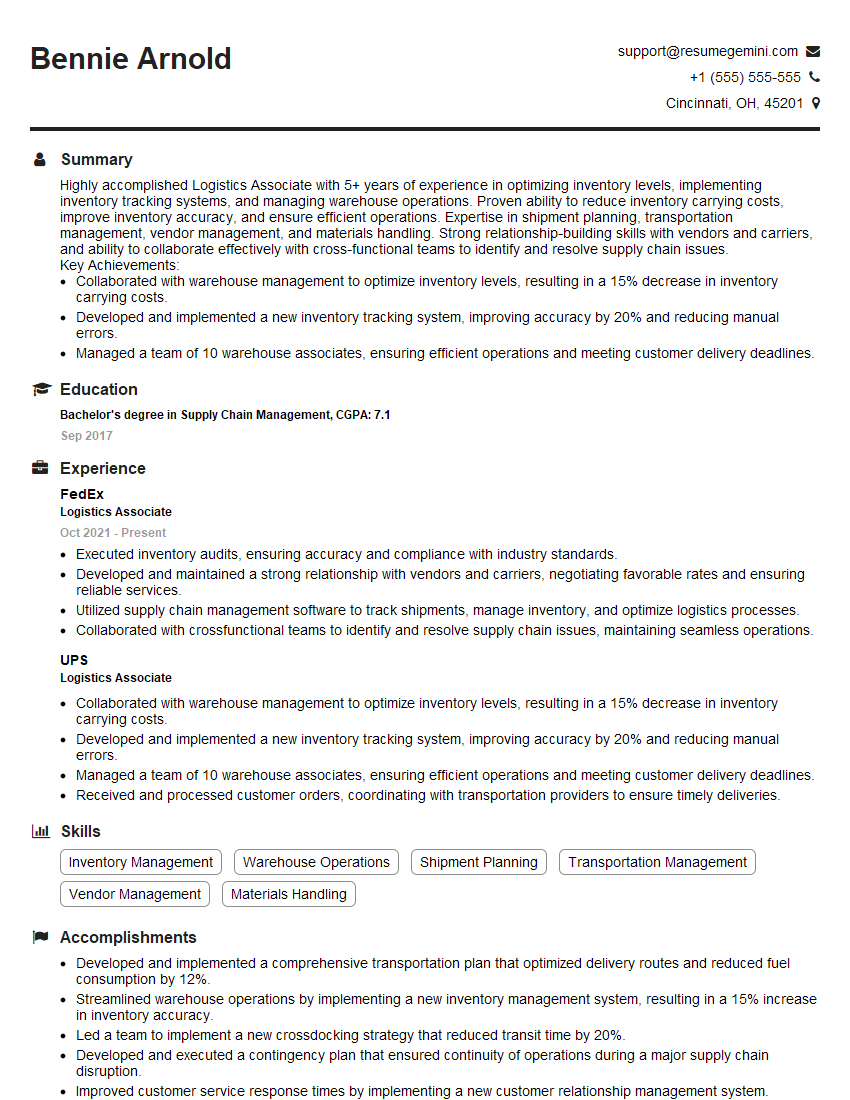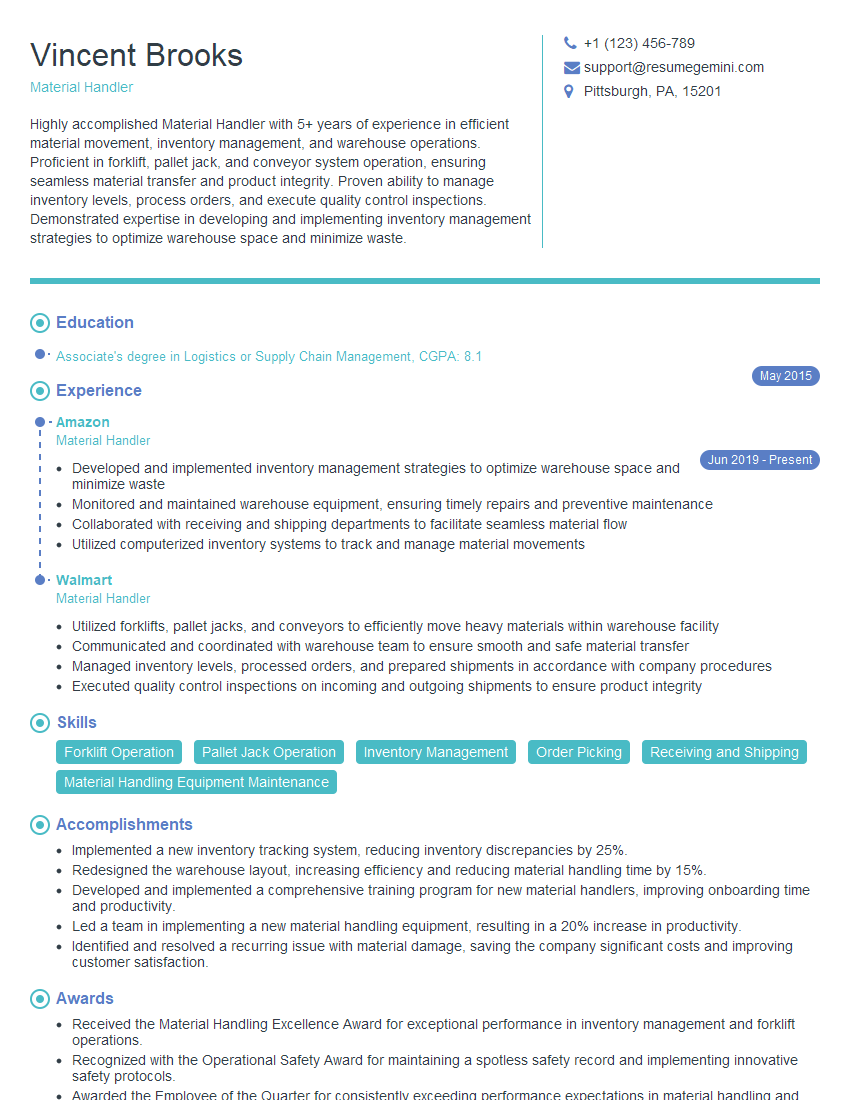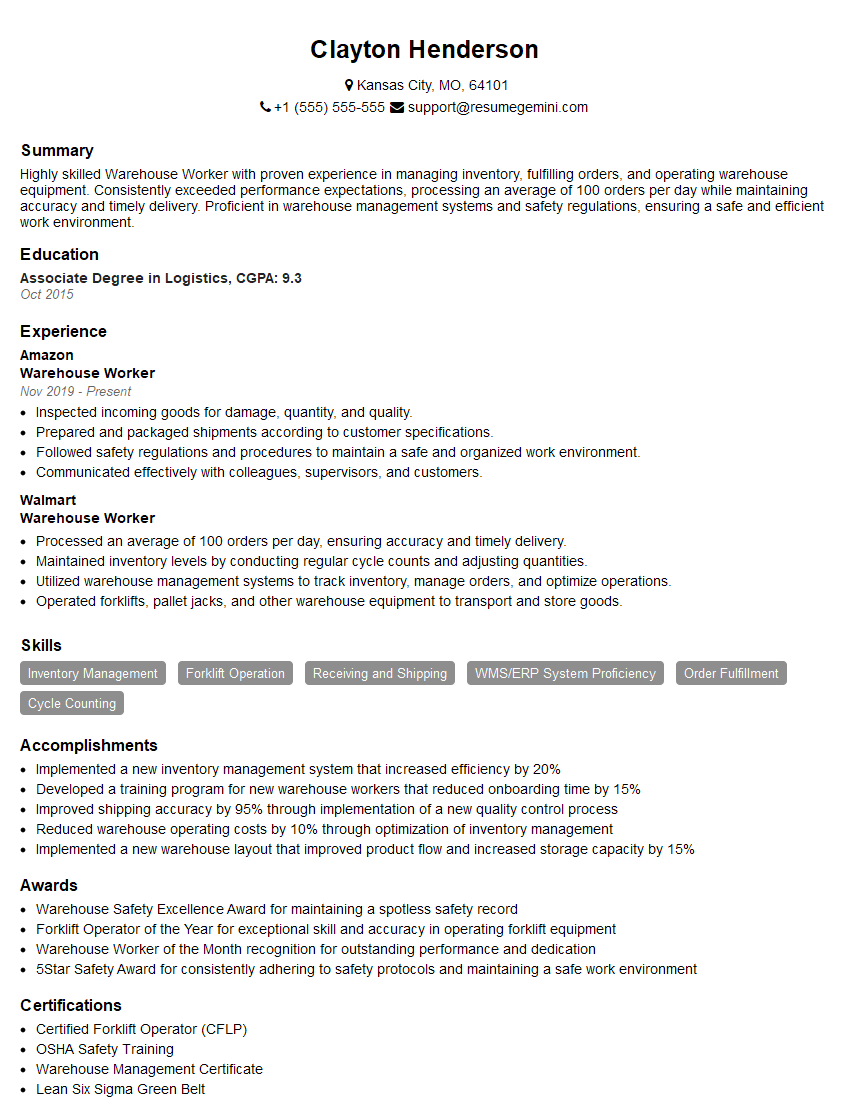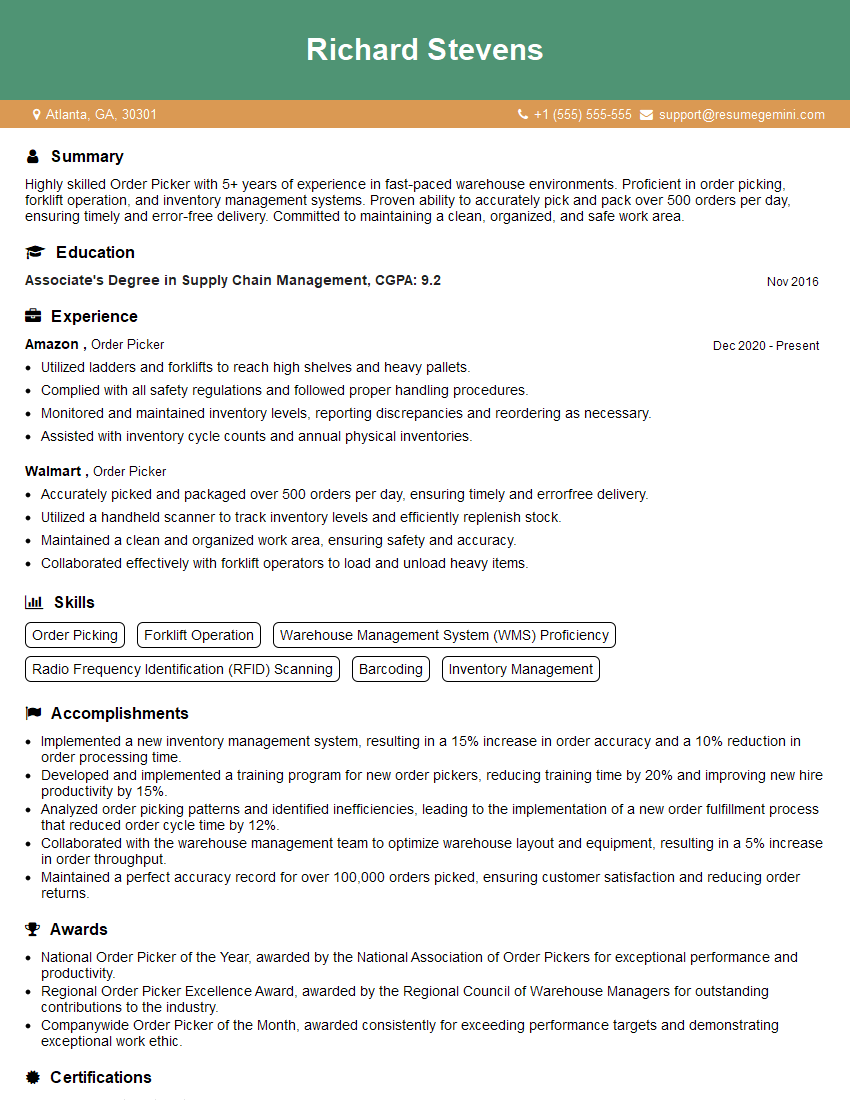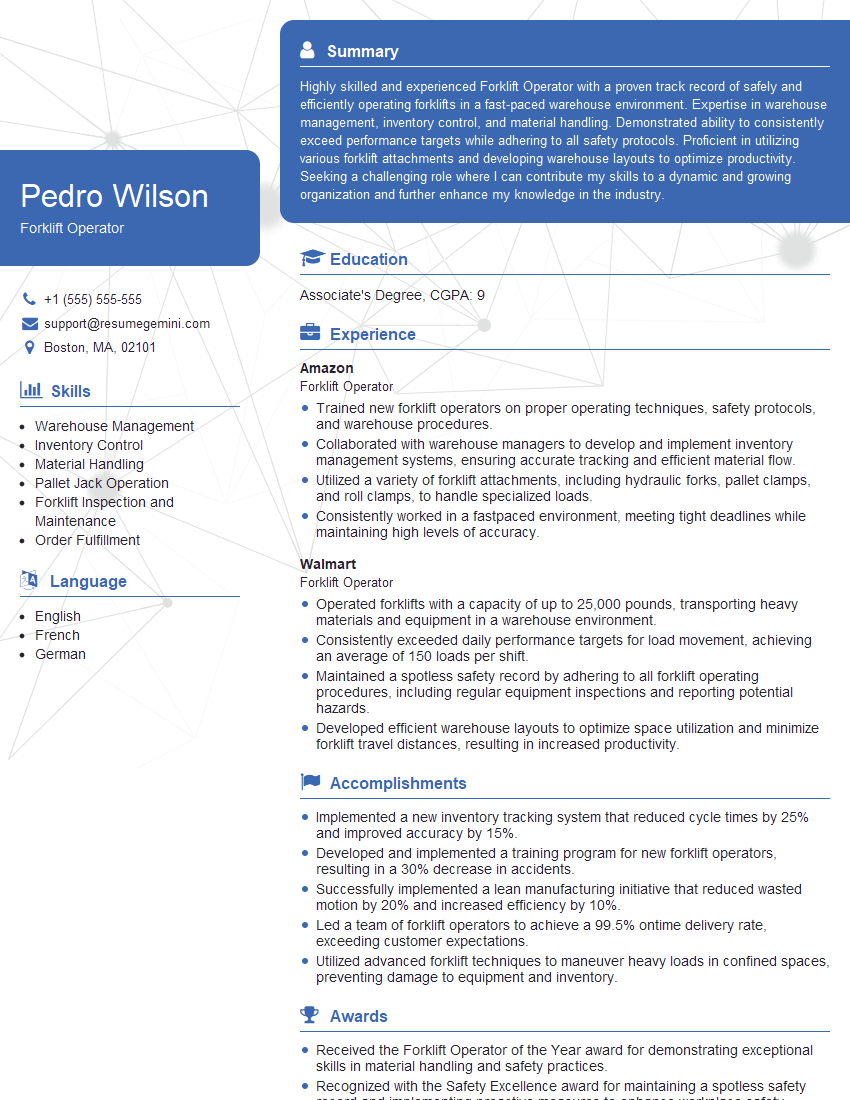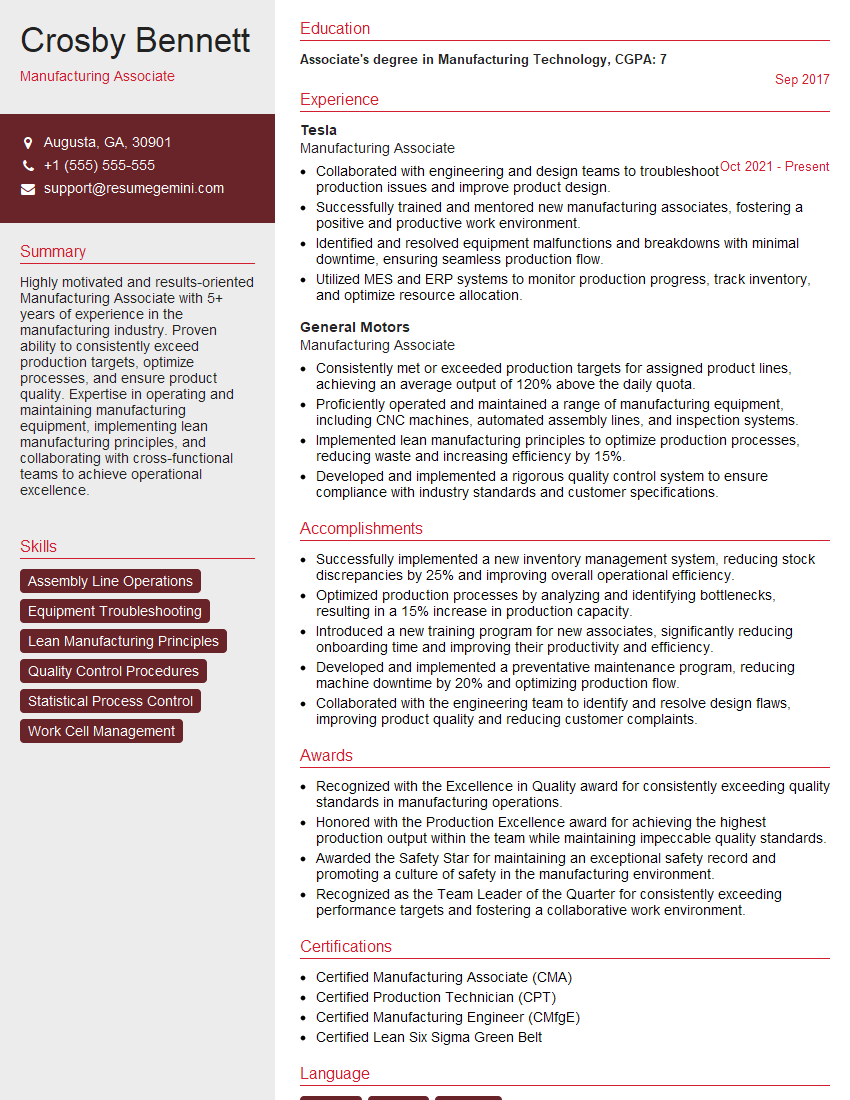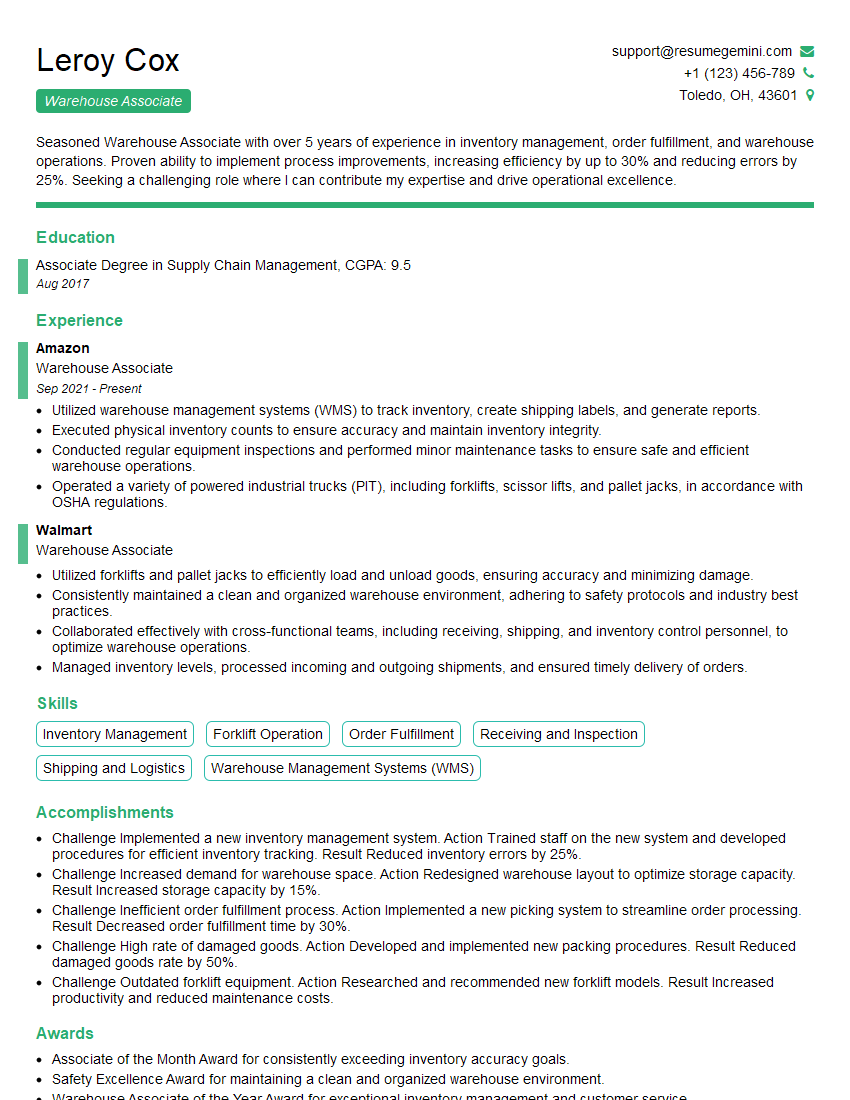Interviews are more than just a Q&A session—they’re a chance to prove your worth. This blog dives into essential Using equipment (e.g., pallet jacks, forklifts) interview questions and expert tips to help you align your answers with what hiring managers are looking for. Start preparing to shine!
Questions Asked in Using equipment (e.g., pallet jacks, forklifts) Interview
Q 1. Describe your experience operating a forklift.
I have over eight years of experience operating various forklift models, including counterbalance, reach truck, and order picker forklifts. My experience spans diverse warehouse environments, from small distribution centers to large-scale logistics facilities. I’m proficient in all aspects of forklift operation, from pre-operational checks and safe operation to loading, unloading, and stacking procedures. For example, in my previous role, I was responsible for the efficient movement of over 500 pallets daily, maintaining a perfect safety record. I’ve also received specialized training in load stability and hazard recognition, ensuring safe and efficient operations in all scenarios.
Q 2. What safety procedures do you follow when operating a forklift?
Safety is paramount when operating a forklift. My safety procedures begin with a thorough pre-operational inspection (detailed in a later answer). Throughout operation, I adhere to the following:
- Always wear a seatbelt: This is crucial for protection in case of accidents.
- Maintain a safe speed: Speed should be adjusted to the conditions, always prioritizing safety over speed.
- Maintain a safe distance from others: I always maintain visual contact with and keep a safe distance from pedestrians and other equipment.
- Use the horn: Sound the horn at intersections and blind corners to alert others of my presence.
- Avoid distractions: Phones, radios, and other distractions are strictly avoided during operation.
- Load stability: Center the load, ensuring stability, especially when navigating turns or inclines.
- Proper lifting techniques: Lifting the forks gradually to ensure a smooth operation and prevent load shifting or damage to the goods.
- Refueling and maintenance procedures: Follow the strict guidelines regarding fuel handling and regular maintenance.
In addition, I am always aware of my surroundings, including potential obstacles, uneven surfaces, and the presence of other workers or equipment. I am certified in forklift operation and regularly undergo refresher training to maintain my skills and knowledge of current safety protocols.
Q 3. Explain the different types of forklifts and their applications.
Forklifts come in various types, each designed for specific applications:
- Counterbalance Forklifts: The most common type, suitable for various tasks in open areas. They have a counterweight to balance the load.
- Reach Trucks: Ideal for narrow aisles, these lift and extend their forks to access high racking.
- Order Pickers: Designed for order fulfillment, allowing the operator to pick items from multiple levels without moving the pallet.
- Sit-down Rider Forklifts: Offer greater stability and comfort for long shifts.
- Stand-up Rider Forklifts: Good maneuverability in confined spaces, useful for shorter tasks.
- Side Loaders: Used for handling long loads such as pipes or lumber.
The choice of forklift depends entirely on the specific application and the warehouse layout. For example, a reach truck is best suited for a high-density storage environment with narrow aisles, whereas a counterbalance forklift is more appropriate for loading and unloading trucks in an open yard.
Q 4. How do you perform a pre-operational inspection of a forklift?
A pre-operational inspection is a crucial step ensuring safe operation. I meticulously check the following:
- Tires: Check tire pressure and condition for any damage or wear.
- Fluid Levels: Inspect engine oil, hydraulic fluid, coolant, and fuel levels.
- Brakes: Test the brakes to ensure proper function.
- Lights and Horn: Verify that lights and the horn are working correctly.
- Fork Alignment: Ensure the forks are level and properly aligned.
- Hydraulic System: Check for leaks and proper functioning of the hydraulic system.
- Steering: Test the steering mechanism for smooth operation.
- Safety Features: Inspect seatbelts, safety guards, and other safety mechanisms.
- Load Capacity: Confirm the load capacity is appropriate for the task.
Any issue found during the inspection necessitates immediate reporting to the supervisor before operating the forklift. This proactive approach minimizes the risk of accidents and ensures safe operation.
Q 5. What are the load capacity limits of a typical forklift?
Load capacity limits vary significantly depending on the forklift model and its configuration. A typical small forklift might have a capacity of 3,000 pounds (1360 kg), while larger models can handle 10,000 pounds (4535 kg) or more. The load capacity is clearly marked on the forklift’s data plate. Exceeding the load capacity significantly increases the risk of tipping and accidents. It’s critical to always check the data plate before handling any load to ensure safe operation. Underestimating the weight of the load is a major safety hazard.
Q 6. How do you handle uneven terrain while operating a forklift?
Operating a forklift on uneven terrain requires extra caution. The key is to proceed slowly and cautiously, adjusting speed and approach based on the severity of the unevenness. I use the following strategies:
- Reduce speed: Significantly decrease speed before approaching uneven surfaces.
- Smooth movements: Avoid sudden acceleration or braking.
- Proper load distribution: Ensure the load is properly secured and centered to maintain balance.
- Assess the path: Carefully assess the path for obstacles and uneven terrain.
- Avoid sharp turns: Avoid sharp turns and abrupt maneuvers, which can destabilize the forklift.
- Use low gear: Use low gear for better control on slopes and uneven ground.
If the terrain is too uneven or hazardous, I will not attempt to operate the forklift in that area and report it to my supervisor. Safety is paramount, and it’s better to err on the side of caution.
Q 7. What are the proper techniques for loading and unloading pallets?
Proper loading and unloading techniques are crucial for safety and efficiency. I follow these steps:
- Positioning: Position the forklift close enough to the pallet but not so close as to risk collision.
- Fork Engagement: Carefully engage the forks under the pallet ensuring they are properly aligned and centered.
- Lifting: Lift the pallet smoothly and gradually, avoiding sudden movements that can cause instability.
- Transportation: Transport the pallet slowly and carefully, observing all safety rules and maintaining awareness of the surroundings.
- Placement: Carefully place the pallet onto the designated area, ensuring the pallet is stable and secure.
- Load Stability: Double-check load stability before moving and avoid shifting of the load during transportation.
- Communication: Communication with other personnel is crucial especially during pallet loading and unloading.
Consistent application of these techniques prevents damage to goods, equipment and ensures safety. For example, improperly loaded pallets could shift, potentially leading to accidents or damage to goods.
Q 8. Describe your experience with pallet jacks.
My experience with pallet jacks spans over eight years, encompassing various warehouse environments and material handling tasks. I’ve operated both manual and electric pallet jacks, moving a wide range of goods, from small boxes to heavy machinery components. I’m proficient in all aspects of operation, including loading, unloading, transporting, and maneuvering in tight spaces. I’m familiar with different load capacities and have consistently demonstrated safe and efficient handling techniques.
For instance, in my previous role at Acme Distribution, I was responsible for moving over 100 pallets daily, consistently meeting deadlines and maintaining a perfect safety record. This experience has honed my skills in quick and efficient pallet jack operation without compromising safety.
Q 9. How do you ensure the stability of loads on a pallet jack?
Ensuring load stability on a pallet jack is crucial for safety and efficiency. It begins with proper pallet construction; ensuring the load is evenly distributed and securely stacked, with no overhanging items. The pallet itself should be structurally sound, free from damage, and appropriately sized for the load.
Before moving, I always visually inspect the load, checking for any shifting or instability. If necessary, I’ll adjust the load to ensure balance. While moving, I maintain a slow and controlled speed, avoiding sudden movements or jerky actions. I’m particularly careful when navigating uneven surfaces or inclines, reducing speed and making extra checks. Think of it like driving a car – smooth, controlled movements are key.
Q 10. What are the safety precautions when using a pallet jack?
Safety is paramount when operating a pallet jack. My safety precautions always begin with a pre-operation inspection: checking the jack’s hydraulics, wheels, and handles for damage or wear. I always ensure the area is clear of obstructions and pedestrians before beginning any operation. I wear appropriate safety footwear, and never operate the jack while distracted or under the influence of drugs or alcohol.
- Load Capacity: Never exceed the jack’s rated load capacity.
- Clear Path: Maintain a clear path, free from obstacles, and be aware of your surroundings.
- Foot Placement: Keep feet clear of the wheels and maintain a safe distance from the load.
- Lifting Techniques: Use proper lifting techniques to avoid back injuries when manually adjusting the load.
- Emergency Stops: Be familiar with the emergency stop mechanism and use it immediately if necessary.
Q 11. How do you handle spills or obstructions while operating equipment?
Handling spills or obstructions requires immediate and careful action. My first response is to immediately stop the pallet jack and assess the situation, ensuring the safety of myself and others. If the spill is hazardous (e.g., chemicals), I’ll immediately report it to my supervisor and follow established spill response procedures, which might include evacuation of the area.
For less hazardous spills (e.g., water), I’ll attempt to carefully clear the obstruction, ensuring I don’t create further hazards. If the obstruction is too large or difficult to remove, I’ll seek assistance and block off the affected area. Safety always comes first. I’ll never attempt to move a pallet jack through a dangerous or obstructed area.
Q 12. What is your experience with different types of pallet jacks?
My experience encompasses various types of pallet jacks, including manual, electric, and those with various load capacities. I’m proficient with both sit-down and stand-up electric pallet jacks, understanding their respective advantages and limitations. I’ve also worked with specialized jacks designed for specific tasks, such as narrow aisle operations. This diverse experience allows me to adapt quickly to different equipment and optimize my work based on the specific demands of the job.
For example, I found that the electric pallet jacks with adjustable lift heights significantly improved efficiency in our high-shelf racking system.
Q 13. How do you maintain the efficiency and safety of your work?
Maintaining efficiency and safety is an ongoing process. It starts with adhering to all safety protocols, completing regular equipment inspections, and reporting any potential hazards. I focus on continuous improvement by looking for ways to streamline my workflows, optimizing routes, and practicing efficient load placement techniques. Regular training and refresher courses are crucial in staying up-to-date with best practices and safety procedures.
I also actively participate in team discussions about improving safety and efficiency in the warehouse. Sharing ideas and learning from others helps us create a safer and more productive work environment for everyone.
Q 14. Describe a time you had to troubleshoot a problem with warehouse equipment.
In a previous role, the hydraulic system of an electric pallet jack suddenly failed mid-operation. The jack stopped responding, leaving me with a half-loaded pallet that needed to be moved urgently. My first step was to ensure the safety of myself and others by securing the area and informing my supervisor.
After confirming the hydraulic system was indeed the issue (by trying to manually lift the forks), I examined the jack’s manual, troubleshooting the possible causes. I checked the hydraulic fluid level and looked for any leaks. After discovering a minor leak in a hose, I carefully documented the issue, marked the jack as out-of-service, and called for maintenance. This situation highlighted the importance of both proactive maintenance and quick thinking in resolving equipment malfunctions safely and efficiently.
Q 15. Explain your understanding of load weight and balance.
Load weight and balance are critical for safe and efficient material handling. Understanding load weight simply means knowing the total weight of the goods being moved. This is crucial because exceeding the weight capacity of the equipment, whether it’s a pallet jack or a forklift, can lead to catastrophic equipment failure and injury. Balance refers to the even distribution of that weight on the equipment. An unbalanced load, even if under the weight limit, can cause tipping, instability, and potential accidents.
For instance, imagine loading a pallet jack. If you stack heavier items on one side, the pallet jack could tilt and become unstable. Similarly, with a forklift, an unevenly distributed load can make steering difficult and dramatically increase the risk of tipping, especially when navigating turns or inclines. Accurately determining the load weight requires using scales or referring to weight information provided by the supplier and ensuring the load is properly centered on the equipment is paramount for safety.
Career Expert Tips:
- Ace those interviews! Prepare effectively by reviewing the Top 50 Most Common Interview Questions on ResumeGemini.
- Navigate your job search with confidence! Explore a wide range of Career Tips on ResumeGemini. Learn about common challenges and recommendations to overcome them.
- Craft the perfect resume! Master the Art of Resume Writing with ResumeGemini’s guide. Showcase your unique qualifications and achievements effectively.
- Don’t miss out on holiday savings! Build your dream resume with ResumeGemini’s ATS optimized templates.
Q 16. How do you prioritize tasks in a fast-paced warehouse environment?
In a fast-paced warehouse, prioritization is key. I use a combination of techniques. First, I identify urgent tasks – those with immediate deadlines or critical impact on operations, such as fulfilling urgent orders. Then, I assess tasks based on their importance, considering factors like order deadlines, product shelf life (perishables), and the potential impact on downstream processes.
I also leverage any available warehouse management system (WMS) to view prioritized tasks and optimize my route. Finally, I focus on continuous improvement – analyzing what works best and adjusting my approach to enhance efficiency and minimize delays. For example, I might group similar tasks together (e.g., picking all orders for a specific zone) to reduce travel time.
Q 17. What is your experience with warehouse management systems (WMS)?
My experience with Warehouse Management Systems (WMS) includes using them to track inventory, manage orders, and optimize warehouse processes. I’m proficient in using various WMS features, including order management, inventory tracking, and task assignment. I’ve used systems that provide real-time updates on inventory levels, location tracking, and order status, which greatly improves efficiency and accuracy. I am comfortable learning new WMS platforms as well. In my previous role, we transitioned from one WMS to another, and I quickly adapted to the new system through the provided training and by proactively seeking help when needed. I’m also comfortable troubleshooting basic WMS issues and reporting them to the IT department if needed.
Q 18. How do you adapt to changes in work assignments or schedules?
Adaptability is essential in warehouse work. I’m comfortable with changing assignments or schedules, viewing them as opportunities to learn new skills and contribute to the team’s success. My approach involves understanding the reason behind the change, obtaining clear instructions from my supervisor, and proactively seeking any necessary training or support. I’m also adept at prioritizing tasks to ensure that deadlines are met even with unexpected shifts in workload or schedule. For example, If a rush order comes in, I would adjust my workflow to prioritize that order without compromising safety or the overall efficiency of operations.
Q 19. How do you communicate effectively with co-workers and supervisors?
Effective communication is crucial in a team environment. I communicate clearly and concisely, both verbally and in writing, ensuring that my message is understood. I actively listen to my coworkers and supervisors, paying attention to both verbal and nonverbal cues. If I encounter a problem or a misunderstanding, I address it directly and professionally, seeking clarification or solutions collaboratively. I also believe in proactive communication; I inform my supervisor of any potential issues or delays promptly. This avoids misunderstandings and allows for timely problem-solving. I often use clear and concise radio communication when operating equipment in a busy warehouse to prevent accidents and keep the team informed of my location and activities.
Q 20. What are your strategies for preventing accidents?
Accident prevention is my top priority. My strategies involve adhering to safety regulations, using equipment properly, and maintaining a vigilant awareness of my surroundings. This includes regular equipment inspections, ensuring that all safety features are functional, and reporting any defects immediately. I also focus on maintaining a clean and organized workspace to prevent trips and falls, and I always prioritize using appropriate personal protective equipment (PPE), such as safety glasses and gloves. Moreover, I’m always mindful of others in the warehouse, communicating my movements and activities clearly to prevent collisions. By consistently following safe operating procedures and being proactive in identifying and mitigating potential hazards, I aim to maintain a safe working environment for myself and my colleagues.
Q 21. Describe your understanding of OSHA regulations related to forklift operation.
My understanding of OSHA regulations concerning forklift operation is comprehensive. I know that operators must be properly trained and certified, and that they must undergo regular refresher training. I’m familiar with the regulations regarding pre-operation inspections, safe operating procedures, load capacity limits, and the importance of maintaining a safe distance from other workers and equipment. I understand the rules regarding operating forklifts on ramps and inclines, and the restrictions related to operating in confined spaces or areas with limited visibility. Furthermore, I am aware of the regulations concerning the use of seatbelts and other safety devices, as well as the penalties for non-compliance. Regular review of these standards is critical in maintaining a safe work environment.
Q 22. How familiar are you with different types of warehouse layouts?
Warehouse layouts significantly impact efficiency. I’m familiar with several, including U-shaped layouts, I-shaped layouts, L-shaped layouts, and more complex designs incorporating dedicated zones for receiving, picking, packing, and shipping. My understanding extends to the impact of aisle width, racking systems (e.g., selective, drive-in, push-back), and the placement of high- and low-demand items. For example, a U-shaped layout is great for smaller warehouses because it optimizes space and minimizes travel distances, while a more complex layout might be necessary for a large distribution center with high throughput.
- U-shaped layout: Efficient for smaller spaces, minimizing travel time.
- I-shaped layout: Simple and linear, suitable for sequential processing.
- L-shaped layout: Offers flexibility and can accommodate varying needs.
Choosing the right layout depends heavily on factors like the volume of goods handled, the type of storage used, and the number of workers. I’ve seen firsthand how a well-planned layout drastically reduces operational costs and improves order fulfillment times.
Q 23. Describe your experience with inventory management procedures.
My experience with inventory management encompasses cycle counting, stock rotation (FIFO/LIFO), and the use of warehouse management systems (WMS). I’ve worked with both manual and automated inventory tracking systems. In my previous role, we utilized a WMS that integrated with our ERP system for real-time visibility into stock levels. This allowed for accurate forecasting of demand and minimized stockouts. For example, we used cycle counting to verify the accuracy of our inventory records on a regular schedule, identifying discrepancies early on and preventing larger problems later. Regular stock rotation (using FIFO – First In, First Out – for perishable goods) was crucial in reducing waste and maintaining product quality.
Q 24. How do you ensure the accuracy of inventory counts?
Ensuring inventory accuracy is paramount. My approach is multi-faceted. It combines regular cycle counting, using barcode scanners or RFID technology for faster and more accurate scanning, and reconciling physical counts with the inventory management system. I’ve found that cross-checking inventory records across multiple systems – for example, the WMS and the ERP system – helps identify and correct discrepancies. Furthermore, thorough training for staff on proper inventory handling procedures, including accurate scanning and recording, is essential. Regular audits of inventory procedures also reveal areas for improvement. Think of it like a meticulous financial accounting process, but for physical goods.
Q 25. What are your methods for optimizing warehouse efficiency?
Optimizing warehouse efficiency involves a holistic approach. It starts with analyzing workflow bottlenecks and streamlining processes. This might include optimizing picking routes using software or implementing cross-docking strategies to reduce handling time. Efficient slotting – placing frequently accessed items in easily reachable locations – is key. Training employees on proper equipment usage and efficient picking techniques also contributes to higher productivity. For instance, in a previous role, we implemented a new picking strategy that reduced picking time by 15% simply by reorganizing the warehouse layout and optimizing picking routes. Furthermore, investing in appropriate equipment such as conveyors, automated guided vehicles (AGVs), or even a warehouse execution system (WES) can significantly improve efficiency depending on scale.
Q 26. How do you maintain a clean and organized work area?
Maintaining a clean and organized warehouse is crucial for safety and efficiency. My approach involves regular cleaning schedules, designated areas for different materials and equipment, and clear labeling of all storage locations. Regular 5S audits (Sort, Set in Order, Shine, Standardize, Sustain) help maintain order and prevent clutter. Employees are actively involved and trained in maintaining cleanliness and orderliness; this creates a culture of responsibility. Think of it like a well-maintained kitchen – a clean and organized space is much safer and more productive. Regular sweeping, mopping, and removal of debris are vital, along with proper disposal of waste materials.
Q 27. How would you handle a situation where a piece of equipment malfunctions?
If equipment malfunctions, my first step is to ensure the safety of myself and others in the vicinity. This involves immediately shutting down the equipment and reporting the incident to the appropriate supervisor. Then, I would assess the situation, determining the nature of the malfunction. Depending on the severity, I may attempt minor repairs if I am trained and authorized to do so; otherwise, I will wait for qualified maintenance personnel. Detailed documentation of the malfunction and any attempted repairs is crucial for future troubleshooting and preventative maintenance. During downtime, alternative equipment may be used or processes adjusted to minimize disruption. Preventing breakdowns through regular preventative maintenance is my priority.
Q 28. What are your career goals related to warehouse equipment operation?
My career goals center on expanding my expertise in warehouse equipment operation and becoming a more efficient and knowledgeable member of the team. I am eager to learn new technologies, like operating automated guided vehicles or working with advanced WMS. I also aim to share my knowledge and train other workers, ensuring consistent safe practices and operational excellence. Ultimately, I want to contribute to creating a highly efficient and safe work environment by becoming a leader in warehouse equipment operation and maintenance.
Key Topics to Learn for Using Equipment (e.g., pallet jacks, forklifts) Interview
- Safe Operation Procedures: Understanding pre-operation checks, proper lifting techniques, load capacity limits, and emergency shutdown procedures for both pallet jacks and forklifts.
- Equipment Maintenance: Knowing basic maintenance tasks like checking fluid levels, tire pressure, and identifying potential mechanical issues. Understanding the importance of reporting maintenance needs.
- Load Stability and Securement: Mastering techniques for safely loading, transporting, and unloading goods, considering weight distribution and load stability to prevent accidents.
- Warehouse Navigation and Maneuvering: Demonstrating awareness of safe operating speeds, appropriate pathways, and obstacle avoidance within a warehouse or storage environment.
- Workplace Safety Regulations: Familiarity with relevant safety regulations and best practices, including personal protective equipment (PPE) requirements and hazard identification.
- Practical Application: Be prepared to discuss scenarios involving various load types, challenging warehouse layouts, and potential safety hazards, outlining your problem-solving approach in each.
- Troubleshooting: Understanding common equipment malfunctions, basic diagnostic steps, and appropriate responses to mechanical issues or operational problems.
Next Steps
Mastering the safe and efficient operation of equipment like pallet jacks and forklifts is crucial for career advancement in logistics, warehousing, and manufacturing. These skills demonstrate responsibility, efficiency, and a commitment to workplace safety – highly valued attributes by employers. To boost your job prospects, create an ATS-friendly resume that highlights these skills effectively. ResumeGemini is a trusted resource to help you build a professional and impactful resume that gets noticed. We provide examples of resumes tailored to highlight experience with equipment operation like pallet jacks and forklifts to help you get started.
Explore more articles
Users Rating of Our Blogs
Share Your Experience
We value your feedback! Please rate our content and share your thoughts (optional).
What Readers Say About Our Blog
good



